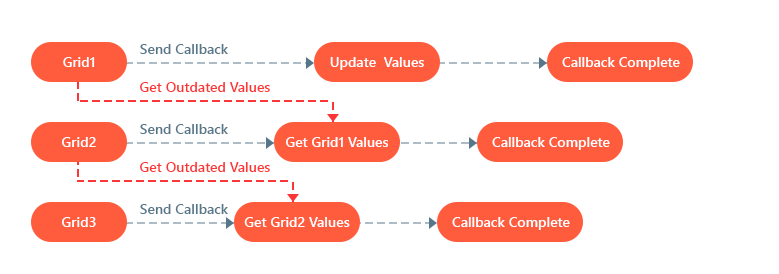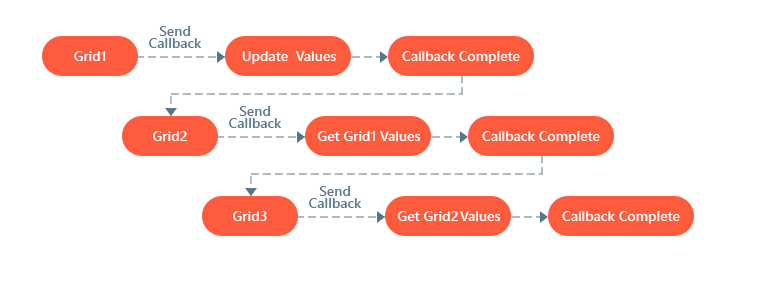Callbacks
- 8 minutes to read
Callbacks allow you to call server code asynchronously and obtain the callback result without a postback. The callback result contains only the updated part of a page. This reduces the network traffic and response time.
Page Lifecycle
Callbacks reduce the page lifecycle. The image below demonstrates a simplified diagram of a postback and callback request processes.

Page Lifecycle During a Postback
In postback mode, an action submits a web page to the server for processing. The server runs the full page lifecycle and sends the new page markup to the client. The client reloads the entire page.
Page Lifecycle During a Callback
In callback mode, an action triggers an asynchronous request to be sent to the web server. The server runs a modified version of a normal page lifecycle where the following steps are skipped:
- The SaveViewState() method is not called. View state information is retrieved and available on the server, but changes made to the state do not persist.
- The PreRender event is not raised.
As a result, less data is sent back to the client and only specific parts of the page is refreshed.
Use the IsCallback property to determine whether the page request is the result of a callback.
Limitations
You cannot update an external control in a callback of another control.
A callback result contains only the updated part of a page. You can find different workarounds in the following topic: Update a Control in a Callback of Another Control (Workarounds).
You cannot download a file during a callback.
When a callback is sent, a client-side object awaits a proper callback result. While the file is downloading, the callback result is cleared and the file content is written to the server response directly. In this case, client-side objects cannot determine the result that is sent to the browser and their state becomes broken. For information on how to upload a file on the client, see the following topic: Download a File on the Client
DevExpress Control Callbacks
Complex DevExpress ASP.NET controls send callbacks to update their own rendering. For instance, ASPxGridView sends callbacks to filter, sort, or edit data. The data is downloaded in the background, invisible to the user. On the client, the data is collected by a JavaScript function and used to update the control state (for instance, to display a new page of records).
Send a Custom Callback
DevExpress controls that support custom callbacks implement the client-side PerformCallback method. Call this method to send a callback to the server. You can pass information from the client side to the server as the method’s parameter. On the server, the PerformCallback method raises the CustomCallback event and passes the specified parameter to the event.
<dx:ASPxRichEdit ID="ASPxRichEdit1" runat="server" ClientInstanceName="richEdit" OnCallback="re_Callback" />
<dx:ASPxFileManager ID="FileManager" runat="server">
<Settings RootFolder="Rich_documents" ThumbnailFolder="~/Thumb/" AllowedFileExtensions=".docx,.doc,.rtf,.txt"/>
<ClientSideEvents SelectedFileChanged="onSelectedFileChanged"/>
</dx:ASPxFileManager>
function onSelectedFileChanged(s, e) {
richEdit.PerformCallback(e.file.GetFullName());
}
protected void re_Callback(object sender, CallbackEventArgsBase e) {
if (!String.IsNullOrEmpty(e.Parameter))
ASPxRichEdit1.Open(Server.MapPath(e.Parameter));
}
More Examples:
- ASPxSpreadsheet - How to add a custom ribbon button and modify an active worksheet on its click
- How to implement the copy / paste appointment operation via the context menu
You can use the JSProperties property to supply server data that should be parsed on the client. The property contains a collection of client property names and their values. Property names should have the cp prefix.
<dx:ASPxGridView ID="ASPxGridView1" runat="server" OnRowDeleted="grid_RowDeleted">
<ClientSideEvents EndCallback="grid_EndCallback" />
</dx:ASPxGridView>
protected void grid_RowDeleted(object sender, DevExpress.Web.Data.ASPxDataDeletedEventHandler e) {
((ASPxGridView)sender).JSProperties["cpDelete"] = true;
}
function grid_EndCallback (s, e) {
if (s.cpDelete) {
delete s.cpDelete;
labelStatus.SetText("The row has been successfully deleted");
}
}
BeginCallback and EndCallback Events
DevExpress ASP.NET controls that support callbacks raise the BeginCallback and EndCallback events before and after each callback. Use an event argument’s command property to determine the action that initiated the callback.
<dx:ASPxGridView ID="Grid" runat="server" KeyFieldName="Id" ClientInstanceName="mainGrid" DataSourceID="mainSource">
<SettingsLoadingPanel Mode="Disabled" />
<SettingsDetail ShowDetailRow="true" />
<Templates>
<DetailRow>
<dx:ASPxGridView ID="GridProducts" ClientInstanceName="gridProducts" runat="server"
DataSourceID="productSource" KeyFieldName="Id">
<ClientSideEvents BeginCallback="onBeginCallback" EndCallback="onEndCallback"/>
</dx:ASPxGridView>
</DetailRow>
</Templates>
</dx:ASPxGridView>
<dx:ASPxLoadingPanel ID="LoadingPanel" ClientInstanceName="loadingPanel" runat="server" Modal="true">
<Image Url="Images/load.gif" Height="50px" Width="50px"></Image>
</dx:ASPxLoadingPanel>
function onBeginCallback(s, e) {
loadingPanel.Show();
}
function onEndCallback(s, e) {
loadingPanel.Hide();
if ((e.command == "ADDNEWROW" || e.command == "UPDATEEDIT")) {
mainGrid.Refresh();
}
}
You can implement a general callback handler. The ASPxGlobalEvents is an invisible control that raises the BeginCallback and EndCallback events when any DevExpress control on a page initiates a callback.
Callback Errors
DevExpress controls include an error-handling mechanism that catches unhandled server exceptions while callbacks are processed. A control fires the client-side CallbackError event and the server-side CallbackError event. For instance, you can handle these events to display a notification or image related to the error.
For more information, see the following topic: Handle Callback Exceptions.
Disable a Control’s Callbacks
Set a control’s EnableCallBacks property to false to force the control to work in postback mode. You can wrap controls in the asp:UpdatePanel to avoid unnecessary postbacks.
<asp:ScriptManager ID="ScriptManager1" runat="server"></asp:ScriptManager>
<asp:UpdatePanel ID="UpdatePanel1" runat="server">
<ContentTemplate>
<dx:ASPxGridView ID="ASPxGridView1" runat="server" EnableCallBacks="false" />
</ContentTemplate>
</asp:UpdatePanel>
ASPxCallback and ASPxCallbackPanel Controls
DevExpress .NET Products include the following controls that are specially designed to work with callbacks.
ASPxCallback
ASPxCallback is a non-visual component that allows you to make a round trip to the server (send a custom callback request) and perform server-side actions. The component cannot update other controls in a callback.
ASPxCallbackPanel
ASPxCallbackPanel is a container area that can dynamically update its content.
Simultaneous Callbacks
When you send a callback to the server, the server starts to update the page and raises page lifecycle events. At the same time, the client-side version of the page still exists and can send another callback. The server is a multi-thread system, and one of its threads may complete faster than another. For instance, if the first callback uses more data than the second callback, the second result is faster than the first. If callbacks use each other during or after a callback, the parallel (or simultaneous) callbacks can work incorrectly.

To avoid such situations, it is recommended to send subsequent callbacks. They function in the following way: the first callback is sent, and the control waits until its result is available in the EndCallback event handler. When the event is raised, the second callback is sent. When the second callback ends, the third callback is sent, and so on.

grid1.PerformCallback();
//...
function grid1EndCallback (s, e) { grid2.PerformCallback(); }
function grid2EndCallback (s, e) { grid3.PerformCallback(); }
You can wrap controls in the ASPxCallbackPanel container to avoid several requests to the server to update/refresh the controls. Send a callback request to this container and update the controls in the server-side Callback event handler.
If your callbacks do not depend on each other, simultaneous callbacks work correctly.
grid1.Refresh();
grid2.Refresh();
grid3.Refresh();
Session State and Simultaneous Callbacks
Simultaneous callbacks do not work if you use the session state. It blocks parallel execution and forces parallel requests to be executed one after another because access to the ASP.NET session state is exclusive per session. For this reason, the example above (How to display progress information about server-side callback processing) does not work if you use the session state.
To avoid this issue, disable the session state at either a page or project level.
Disable the Session State at a Page Level
Set the EnableSessionState property to False to disable the session state at a page level.
<%@ Page Language="C#" CodeFile="Default.aspx.cs" Inherits="_Default" EnableSessionState="False" %>
Alternatively, you can set the Page EnableSessionState property to ReadOnly. In this case, the session state is enabled but not writable.
Disable the Session State at a Project Level
Set the sessionState mode to off to disable the session state at project level.
<system.web>
<sessionState mode="Off"></sessionState>
</system.web>
When the session state is disabled, it is no longer possible to use session variables. You can use the following alternatives:
- Application state stores variables that all users of an ASP.NET application can access.
- Profile properties persists user values in a data store without expiring them.
- ASP.NET caching stores values in memory that is available to all ASP.NET applications.
- Cookies
- The query string and fields on an HTML form that are available from an HTTP request.